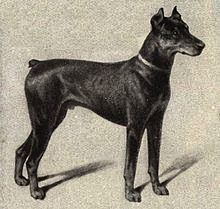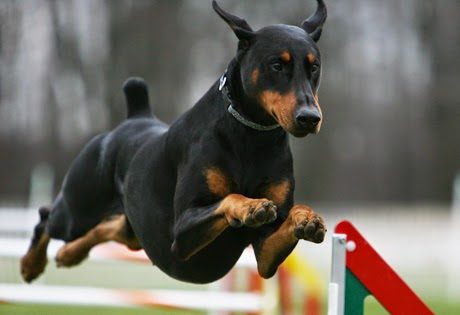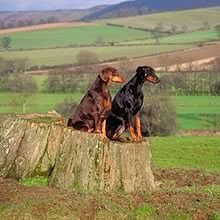Although the Doberman has a reputation as a sharp and even sinister dog, his devoted fans consider him the most loving and loyal of companions. Believe it or not, a good Doberman is a stable, friendly dog – unless you threaten his family.
The Doberman Pinscher was developed in Germany during the late 19th century, primarily as a guard dog. His exact ancestry is unknown, but he’s believed to be a mixture of many dog breeds, including the Rottweiler, Black and Tan Terrier, and German Pinscher. With his sleek coat, athletic build, and characteristic cropped ears and docked tail, the Doberman Pinscher looks like an aristocrat. He is a highly energetic and intelligent dog, suited for police and military work, canine sports, and as a family guardian and companion.

Overview
Because the Doberman Pinscher came into existence at the end of the 19th century, he is, in the world of dogs, the new kid on the block. This hasn’t stopped the Dobie, as he is affectionately called, from becoming one of the most popular and recognized breeds in the United States.
His look is elegant and his style is athletic; the Dobie is also intelligent, alert, and loyal. He is a courageous guard dog as well as a beloved family companion.
The Dobie’s fierce reputation precedes him. He is feared by those who don’t know him, stereotyped as highly aggressive and vicious. True, he is a formidable guardian, but he is usually a gentle, watchful, and loving dog. He does not go looking for trouble, but he is fearless and will defend his family and turf if he perceives danger.
The Doberman Pinscher enjoys being part of a family. He likes to be close to those he loves and, when this love is present, he is a natural protector. He is trustworthy with his family’s children, friends, and guests as long as he is treated kindly.
In spite of his positive qualities, the Dobie isn’t the right breed for everyone. He’s large, at 60 to 80 pounds, and he’s extremely active, both physically and mentally. He needs a lot of exercise.
He also needs plenty of mental challenges to keep him from becoming bored. He needs a strong owner/pack leader who can take time to properly socialize and train him, and who will keep him busy every day. This may be too much to handle for people who lead a more laid-back lifestyle.
The current look of the Dobie is slimmer and sleeker than that of past years. His temperament has also changed somewhat, say breed enthusiasts, softening a bit from his early days in Germany, though he is still an excellent guard dog.
Originally, Dobies’ ears were cropped to increase their ability to locate sounds, and tail docking gave the breed a more streamlined look. North American breeders usually dock the tails and crop the ears of Doberman puppies, though it’s not mandatory. Docking and ear cropping is illegal in some countries.
Those who know him say that a well-bred and properly socialized Dobie is an excellent pet and companion, suitable for families with other dogs, gentle with young children, and overall a loyal and devoted family member.
Highlights

- The Doberman has a great deal of energy and needs a lot of exercise.
- This breed can be protective, so don’t be surprised when he assumes the role of household guardian.
- The Dobie will assume the alpha role in your household if you’re not a strong leader. Early, consistent training is critical to establish your role as pack leader.
- The Dobie is sensitive to cold weather and needs adequate shelter in winter (he likes to be in the house next to the fireplace).
- The Doberman Pinscher is a family dog and shouldn’t be left alone. He thrives when he’s included in family activities.
- The Doberman has gained a reputation as being vicious. Even though your Doberman may have a sweet personality, neighbors and strangers may be afraid of him.
- To get a healthy dog, never buy a puppy from an irresponsible breeder, puppy mill, or pet store. Look for a reputable breeder who tests her breeding dogs to make sure they’re free of genetic diseases that they might pass onto the puppies, and that they have sound temperaments.
Other Quick Facts
- The Doberman originated in Germany, created by tax collector Louis Dobermann to keep himself and the taxes he carried safe from thieves.
- In the 1950s, long before the advent of agility and freestyle competitions, the Doberman Drill Team thrilled audiences with their amazing physical feats. Today the breed is highly competitive in obedience and agility trials as well as many other dog sports and activities.
- The Doberman who is raised with children and other pets will love and protect them and be a good companion for kids.
- The first Doberman to win Best in Show at Westminster was Ch. Ferry v Raufelsen of Giralda in 1939. He was followed by his grandson, Ch. Rancho Dobe’s Storm, who had back to back wins in 1952 and 1953 and more recently by Ch. Royal Tudor Wild as the Wind in 1989.
UKC group: Guardian Dog
Average lifespan: 10-11 years
Average size: 66-88 pounds
Coat appearance: Short, hard, thick
Coloration: Black, red, blue, and fawn
Hypoallergenic: No
Other identifiers: Athletic build, muscular body, ears pricked and erect, tail short and cropped
Possible alterations: Dobermans are born with floppy ears and long tails.
History
Doberman Pinschers were first bred in the town of Apolda, in the German state of Thuringia around 1890, following the Franco-Prussian War by Karl Friedrich Louis Dobermann. Dobermann served in the dangerous role of local tax collector, and ran the Apolda dog pound. With access to dogs of many breeds, he aimed to create a breed that would be ideal for protecting him during his collections, which took him through many bandit-infested areas. He set out to breed a new type of dog that, in his opinion, would be the perfect combination of strength, speed, endurance, loyalty, intelligence, and ferocity. Later, Otto Goeller and Philip Greunig continued to develop the breed to become the dog that is seen today.

The breed is believed to have been created from several different breeds of dogs that had the characteristics that Dobermann was looking for, including the German Pinscher, the Beauceron, the Rottweiler, the Thuringian Sylvan Dog, the Greyhound, the Great Dane, the Weimaraner, the German Shorthaired Pointer, the Manchester Terrier, the Old German Shepherd Dog, the American Pit Bull Terrier, Thuringian Shepherd Dog . The exact ratios of mixing, and even the exact breeds that were used, remain uncertain to this day, although many experts believe that the Doberman Pinscher is a combination of at least four of these breeds. The single exception is the documented crossing with the Greyhound and Manchester Terrier. It is also widely believed that the old German Shepherd gene pool was the single largest contributor to the Doberman breed. Philip Greunig’sThe Dobermann Pinscher (1939), is considered the foremost study of the development of the breed by one of its most ardent students. Greunig’s study describes the breed’s early development by Otto Goeller, whose hand allowed the Doberman to become the dog we recognize today. The American Kennel Club believes the breeds utilized to develop the Doberman Pinscher may have included the old shorthaired shepherd, Rottweiler, Black and Tan Terrier and the German Pinscher.

After Dobermann’s death in 1894, the Germans named the breed Dobermann-pinscher in his honor, but a half century later dropped the ‘pinscher’ on the grounds that this German word for terrier was no longer appropriate. The British did the same a few years later.
During World War II, the United States Marine Corps adopted the Doberman Pinscher as its official War Dog, although the Corps did not exclusively use this breed in the role.
In the post war era the breed was nearly lost. There were no new litters registered in West Germany from 1949 to 1958. Werner Jung is credited with single-handedly saving the breed. He searched the farms in Germany for typical Pinschers and used these along with 4 oversized Miniature Pinschers and a black and red bitch from East Germany. Jung risked his life to smuggle her into West Germany. Most German Pinschers today are descendants of these dogs. Some pedigrees in the 1959 PSK Standardbuch show a number of dogs with unknown parentage.
In the United States, the American Kennel Club ranked the Doberman Pinscher as the 12th most popular pure-breed in 2012 and 2013.
Personality
A super-intelligent and super-active dog — that’s what you get when you get a Doberman Pinscher. You also get an extremely loyal, trustworthy dog who’s playful and fun-loving with his family. He’s a natural protector who won’t hesitate to act when he thinks his family is under threat, but he is not aggressive without reason.
The Dobie likes to be busy, physically and mentally. He learns quickly, and training him is easy. Because he learns so fast, it’s challenging to keep lessons fresh and interesting. He can have his own ideas about things, though typically he’s not overly stubborn or willful with an owner who provides consistent, kind leadership.
The Dobie takes a while to grow up. He remains puppyish until he is three to four years old.
Temperament is affected by a number of factors, including heredity, training, and socialization. Puppies with nice temperaments are curious and playful, willing to approach people and be held by them. Choose the middle-of-the-road puppy, not the one who’s beating up his littermates or the one who’s hiding in the corner.
Always meet at least one of the parents — usually the mother is the one who’s available — to ensure that they have nice temperaments that you’re comfortable with. Meeting siblings or other relatives of the parents is also helpful for evaluating what a puppy will be like when he grows up.
Like every dog, the Dobie needs early socialization — exposure to many different people, sights, sounds, and experiences — when they’re young. Socialization helps ensure that your Dobie puppy grows up to be a well-rounded dog.
Enrolling him in a puppy kindergarten class is a great start. Inviting visitors over regularly, and taking him to busy parks, stores that allow dogs, and on leisurely strolls to meet neighbors will also help him polish his social skills.
Health
The Doberman Pinscher has a lifespan of 10 to 12 years. Wobbler’s syndrome, cervical vertebral instability (CVI), and cardiomyopathy are some serious health problems affecting Dobermans; some minor diseases seen in this breed of dog include canine hip dysplasia (CHD), osteosarcoma, von Willebrand’s disease (vWD), demodicosis, and gastric torsion. Albinism, narcolepsy, hypothyroidism, and progressive retinal atrophy (PRA) are occasionally seen in Dobermans, while the Blue Doberman is more prone to hair loss. To identify some of these issues, a veterinarian may run cardiac, eye, hip, and DNA tests.
Living Conditions
Will do okay in an apartment if sufficiently exercised, but does best with at least an average-sized yard. Dobes are very cold sensitive and are not outside dogs. That is why police in areas where it gets cold are not able to use them.
Exercise
The Doberman is very energetic, with great stamina. They need to be taken on a daily, long walk or jog, and need to be made to heel beside or behind the human holding the lead, as in a dog’s mind the leader leads the way and that leader needs to be the humans.
Care
The Doberman requires mental and physical exertion daily or it may become destructive or frustrated. This need can be easily met with a walk on a leash, a run in an enclosed area, or a long jog. And while it can live outdoors in cool climate, the Doberman is most effective indoors as a guardian and a family companion. Its coat requires minimal care.
Grooming
Grooming is a breeze. Brush the Doberman with a slicker brush or hound glove every week, or even just run a wet towel over him. On the days he needs a bath, use a dog shampoo, not a human product. Rinse thoroughly and let him shake dry or towel-dry him.
The Doberman sheds moderately. Regular brushing will help keep him and your home neat. As with any dog, brushing before a bath helps eliminate more dead hair, which leaves less hair to shed. Your vacuum cleaner will work longer if you brush your Doberman regularly.
The rest is basic care. Trim his nails as needed, usually every few weeks. Brush his teeth for good overall health and fresh breath.
Is this breed right for you?
The Doberman Pinscher is definitely not right for everyone. This is a highly intelligent breed meant to guard and work, and its owners must have the time and dedication to provide proper upbringing to this potentially dangerous breed, especially for households with young children. Highly trainable and loyal, the Doberman Pinscher makes a wonderful addition to an experienced household. This is a tidy breed as it does not shed much and has a low-maintenance grooming routine.
Children and other pets
The well-bred Doberman is a wonderful family dog. He is trustworthy and protective of the children in his family, as long as he’s been socialized and trained appropriately. Children must be respectful and kind to the Dobie, and he will be just that in return.
As with every breed, you should always teach children how to approach and touch dogs, and always supervise any interactions between dogs and young children to prevent any biting or ear or tail pulling on the part of either party. Teach your child never to approach any dog while he’s eating or sleeping or to try to take the dog’s food away. No dog, no matter how friendly, should ever be left unsupervised with a child.
He’s also friendly with other dogs and animals in his home, especially if he has been raised with them. He can be aggressive toward dogs outside his family if he considers them a threat to his loved ones.
Famous Doberman Pinschers
- Graf Belling v. Grönland: first registered Dobermann, in 1898.
- First Doberman registered with the American Kennel Club, 1908
- Ch. Big Boy of White Gate (owner/breeder Howard K. Mohr) wins the 1st Best in Show for an American-bred Doberman at the Rhode Island Kennel Club show, 1928.
- Ch. Ferry v Raufelsen of Giralda (owner/breeder Mrs. M Hartley Dodge) is the first Doberman to win Best in Show at the Westminster Kennel Club show, 1939
- Kurt, A Doberman who saved the lives of 250 U.S. Marines when he alerted them to Japanese soldiers. Kurt became the first k-9 casualty, July 23, when he was mortally wounded by a Japanese grenade. He was the first to be buried in what would become the war dog cemetery and he is the dog depicted in bronze sitting quiet but alert atop the World War II War Dog Memorial. Kurt, along with 24 other Dobermans whose names are inscribed on the memorial, died fighting with the US Marine Corps against Japanese forces on Guam in 1944.
- Ch. Rancho Dobe’s Storm: back to back Westminster Best in Show (1952, 1953). While other Dobermans may have more group or best in show or even more breed wins than Ch Rancho Dobe’s Storm, he remains the only Doberman that has never been defeated by another Doberman.
- Bingo von Ellendonk: first Dobermann to score 300 points (perfect score) in Schutzhund.
- Ch. Cambria Cactus Cash: Sired 155 AKC champions as of January 2011.
- Ch. Borong the Warlock: won his championship title in three countries, including 230 Best of Breed, 30 Specialty Show “bests,” six all-breed Best in Show, and 66 Working Groups. He was the only Doberman ever to have won the Doberman Pinscher Club of America National Specialty Show three times, and in 1961 five Doberman specialists judged him Top in the breed in an annual Top Ten competition event.
- Am. Ch. Brunswigs Cryptonite: achieved Best In Show on 124 occasions
Did You Know?
Doberman’s get a bad reputation as attack dogs. Alpha in the Academy Award-winning film “UP” embodies every stereotype of the Doberman Pinscher: he’s both mean and not very smart. Fortunately, he’s also fictional and nothing like a real Doberman.
A dream day in the life of a Doberman Pinscher
The Doberman Pinscher is a dog who thrives on work. Give this workaholic a job and he’ll be the happiest pup on the block. Whether it’s standing guard for the household, getting involved with search and rescue or any other type of accelerated training, this no-nonsense breed is up for the challenge.










